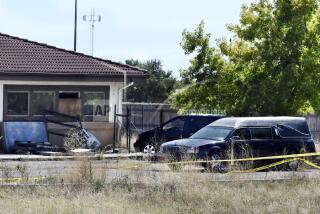A Lively Business in Funerals
- Share via
They began as livery stable owners, providing horse-drawn drays for cargo and passengers.
Then they happened on every businessman’s dream--a steady stream of customers incapable of complaint.
In short order, the Pierce brothers--descendants of President Franklin Pierce--had 21 funeral homes, one cemetery and crematory, and a college bearing their name scattered across the Los Angeles landscape. Started by two visionary brothers, the enterprises ultimately enlisted the efforts of their eight siblings, who included a doctor, lawyer, Baptist minister, educator and businessmen running the family’s funeral homes, ambulance and insurance companies.
*
In 1880, William Pierce arrived in Los Angeles from upstate New York and purchased farmland where County-USC Medical Center stands today. A year later, his brother Fred followed, and together they opened a livery stable at Alameda and 16th streets from which they began shipping cargo and passengers.
Helped by the era’s land boom and railroad fare war, business zoomed. And as the city’s population climbed from 11,000 to 50,000, the Pierce brothers soon found that their liveliest line of work involved transporting the dead.
With seven practicing physicians in the city and only two undertakers to dispose of their failures, the brothers began to carry bodies from homes to the cemetery.
But with their gift of gab and an unflagging belief that liverymen could provide respect and dignity for the dead--without the high cost of a fancy funeral--they added the name “undertaker” to the Pierce Bros. sign.
*
More brothers came West to join the firm, including Clarence, who lived with William on the farm while earning his medical degree from USC in 1898. He practiced medicine for the next 30 years, at one point delivering half the babies in Los Angeles.
Trading in the livery stable and the horse-drawn hearse for a motorized model, Pierce Bros. moved to 8th and Flower streets in 1902. There, they converted a boardinghouse into a mortuary with a chapel next door.
In 1924, after selling the Flower Street property to the Southern California Gas Co., the Pierce siblings built what would become their landmark Mission-style mortuary at 720 W. Washington Blvd., the first full-service funeral home built in the city. It still stands today.
One of their innovations from that era was trolley service--complete with a plush funeral parlor car built to carry a coffin, flowers, pallbearers and mourners. It was cheaper, faster and more convenient than a string of chauffeur-driven limos moving at a snail’s pace along Washington Boulevard to Rosedale Cemetery.
*
In 1933, Clarence Pierce, the extroverted family physician, joined his brothers in the mortuary business. Known for his charm and powers of persuasion, Clarence, a school board member, would later cajole skeptics into opening an agricultural college on 392 acres in Woodland Hills. Established in 1947, Pierce College is one of the nine campuses in the Los Angeles Community College District named for a person.
With Clarence on board, the brothers began trying new types of marketing schemes.
Attempting to dispel myths and lay to rest the morbid view of mortuaries, Pierce Bros. began offering local church groups tours of the mortuary and embalming room. Donations of $1 a head went to the churches for their spiritual role in the behind-the-scenes look.
There also were benefits to be had from the public’s increasing preoccupation with celebrity. The mysterious 1935 death of the “Vamping Venus,” actress and comedian Thelma Todd, brought thousands of mourners to the Pierce Bros. mortuary on Washington Boulevard.
Later that year, another sort of crowd crashed the mortuary doors. Actress Tallulah Bankhead, out on the town with a bunch of tipsy friends, rushed in and demanded a tour of the mortuary.
Intent on burying the competition, as well as their patrons, Pierce Bros. bought out W.A. Brown and Son, a former street car conductor and clothier-turned-mortician, who had the “largest casket display in the world” and offered a complete funeral for as low as $290 during the Depression.
Over the years, some Angelenos have taken a humorous and sometimes bizarre approach to funerals and dying, recalls Ralph Head, who worked for Pierce Bros. for more than 50 years.
“Once a woman left her fortune to maintain 30 cats and requested a small orchestra play for three consecutive nights while friends and relatives visited her. But no one showed up during visitation hours or at the funeral.”
Head also put to rest the popular Hollywood legend that Errol Flynn stole John Barrymore’s body from Pierce Bros. mortuary and brought it back to the Beverly Hills Hotel so Barrymore could be present at his own drunken wake. “It never happened. It just made a colorful story for Flynn’s autobiography,” Head said.
Msgr. Francis J. Weber, curator of the San Fernando Mission and archivist for the archdiocese of Los Angeles, who worked for Pierce Bros. for a number of years, recalls driving a hearse called “Wrinkles” that always got stuck in second gear and had a hand-carved wooden body displayed on the door.
In the 1940s, Pierce Bros. began expanding by buying up smaller mortuaries, an insurance company and the 63-acre Valhalla Cemetery in North Hollywood.
In 1959, after handling more than 12,000 funerals a year, Pierce Bros. sold its family-owned chain--the largest in the nation--of 21 mortuaries and three cemeteries, including ones in Riverside and Newport Beach, for about $6.5 million.
Pierce Bros. now is run by Service Corp. International, the world’s reigning funeral giant.
More to Read
Sign up for Essential California
The most important California stories and recommendations in your inbox every morning.
You may occasionally receive promotional content from the Los Angeles Times.













